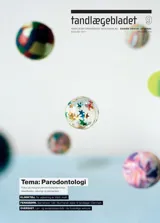Parodontale sygdommes klassifikation: en praksisrelateret indfaldsvinkel
Behandlinger i sundhedssektoren forudsætter en korrekt diagnose. I den daglige tandlægepraksis vurderes de parodontale væv ved anvendelse af en række kliniske parametre, typisk pochemål, klinisk fæstetab, blødning ved pochemåling og radiologisk knogletab. Vurderingen af en patient med parodontal sygdom kræver imidlertid en række supplerende oplysninger. Da den individuelle tilbøjelighed til at udvikle fæstetab er stærkt varierende, og da behandlingen kan variere afhængigt af denne tilbøjelighed, er det afgørende, at der til den enkelte patient knyttes en overordnet diagnose, fx kronisk eller aggressiv marginal parodontitis, baseret på sygdomsaktiviteten. Da de kliniske fund på det enkelte site også er afgørende for behandlingen, er de detaljerede oplysninger om de sygdomsramte sites naturligvis nødvendige. Oplysninger om sygdommens udbredelse, dvs. antal involverede sites/ tænder og sværhedsgrad, dvs. størrelsen af fæstetabet, er imidlertid også nødvendige for en fyldestgørende beskrivelse af sygdommen. De behov, der knytter sig til forskningsmæssig anvendelse af data og til anvendelsen i det daglige kliniske arbejde, er ikke sammenfaldende, og de problemer, der er i forbindelse med valget af sygdomskriterier, indebærer en fortsat diskussion. Der er således ikke nogen definition af en parodontitispatient, der nyder bred international anerkendelse. Forfatterne har med udgangspunkt i internationalt anerkendte klassifikationssystemer udarbejdet et klassifikationssystem, der med fordel kan finde anvendelse i praksis.
Classifi cation of periodontal diseases: a practice related approach
Any treatment in the health system is based on a correct diagnosis. In the dental offi ce the status of periodontal tissues is characterized by the use of a number clinical parameters including probing pocket depth, clinical attachment level, bleeding on probing and radiographic bone loss. Additional information is needed, however, for the evaluation of periodontal diseases. The individual susceptibility to acquiring attachment loss shows major variation and as the treatment of choice may vary depending on disease susceptibility, it is important to attach a diagnosis, such as chronic or aggressive periodontitis, at an individual level to refl ect this characteristic. As the treatment is dependent on the clinical features at the single site, information is also required describing these details. Information on the extent of the disease, for example number of involved sites/teeth and severity of the disease, and similarly on magnitude of attachment loss is required to fully describe the periodontal condition. The information requirements associated with research and daily clinical work are not the same, and the problems associated with the establishment of diagnostic criteria for clinical disease are subjected to constant discussion and development. In fact, there is so far no universally approved defi nition of a periodontitis patient. Based on internationally approved systems, a classifi cation system of periodontal disease adapted for daily clinical use is proposed in the present article as a basis for a standardised system.


